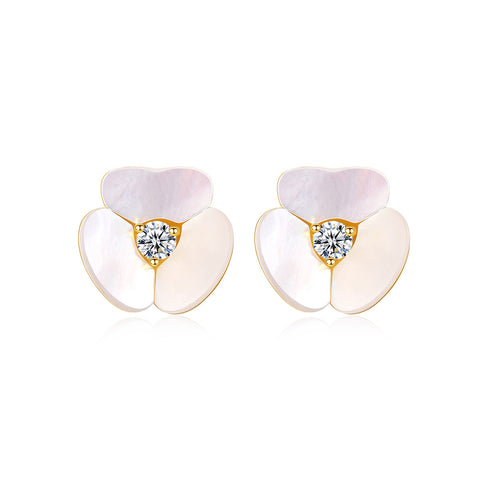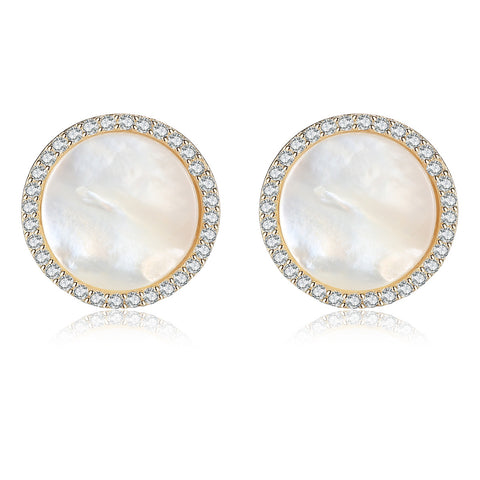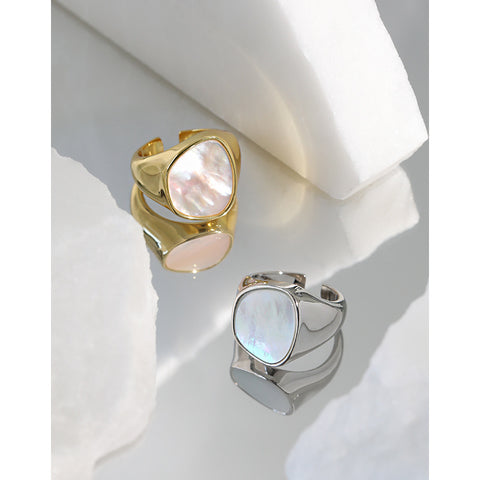
Mother of pearl is similar to pearls in that it is made of the same material. But in many ways, mother-of-pearl is its own "gem." Perfect for unique jewelry, stylish craftsmanship, and beautiful decoration, mother-of-pearl has many uses.
Versatile, affordable and plentiful, it's ideal for jewelry. Read on if you're interested. We've covered everything you need to know about buying mother of pearl jewelry.
What is Mother of Pearl?
Mother of pearl, or nacre, is the iridescent substance that forms inside the shells of many mollusks (think mussels and pearl oysters). As a defense mechanism, mollusks secrete nacre to defend against irritants and abrasions that enter the shell. The nacre then forms along the surface of the shell, creating a shiny, iridescent finish known as mother-of-pearl. It is an organic-inorganic composite material made of aragonite (a type of calcium carbonate), and pearls are also made of aragonite, so they are strong, elastic and iridescent. The best part? No two pieces of mother-of-pearl are exactly the same, so it is used to create unique, one-of-a-kind pieces. You'll often find it as a decorative inlay on watch dials or jewelry, and it's soft enough to be engraved and engraved, further enhancing its uniqueness.

What is the Difference between Mother of Pearl and Pearls?
Most mollusks produce mother of pearl, but very few mollusks produce pearls. Mother of pearl can be harvested from oysters, clams, freshwater mussels, and abalone, to name a few, each with slightly different color variations. For example, abalone found in South Africa, Australia, New Zealand and Japan produces some of the world's most lustrous and colorful mother-of-pearl varieties, such as blues, greens and purples. However, abalone does not produce pearls. Pearls are more valuable than mother-of-pearl due to the low percentage of mollusks that produce them.
Like pearls, mother-of-pearl is usually cream, white, or off-white, but gray, silver, yellow, black, teal, purple, and red can also be found in rare varieties. The color depends on the type of mollusk in which it is found. Because mother-of-pearl covers a larger area in the shell, it is often used for larger objects, such as dials, while pearls are round and made into beads.
The Color of Mother of Pearl
The appearance of mother-of-pearl is usually opaque to translucent, and the color is usually white, cream, or off-white. However, you'll also encounter gray, silver, yellow, black, teal, and red varieties.
The color of the gemstone depends on the mollusk, with abalone being the most vibrant, lustrous, and colorful variety. Abalone mother-of-pearl is blue, green and purple.
What is the Meaning of Mother of Pearl?
Mother-of-pearl is the term for the inner layer or nacre of a mollusk shell.
It is a stone given on the first wedding anniversary and is most often associated with elegant and feminine jewelry.
The name mother-of-pearl is said to derive from the fact that the nacre-lined shell is the belly that produces the pearls. It's a beautiful metaphorical name for the magical underwater creative process.
You can also check the article: What Does the Pearl Symbolize
Is Mother of Pearl Valuable?
Mother-of-pearl is a common substance in a variety of mollusks, so it is not considered very rare. Pearls, on the other hand, are more difficult to find and create, so they are very rare and quite expensive. The more abundant and persistent supply of mother-of-pearl makes it relatively affordable and readily available.
Although naturally abundant and affordable, the popularity of mother-of-pearl has declined in recent years. This is mainly due to the fact that the industries that use it frequently do not want to support unsustainable and often unethical farming practices. There are some people and industry leaders who actively seek out the ethical farming of mother of pearl.
If you want to buy mother-of-pearl in any form, it's best to do some research on the company or person you're buying from. Make sure to check that they support the environmentally friendly and ethical growing and cultivation of pearls and mother of pearl.
You can also check the article: How Much are Pearls Worth
Mother of Pearl Jewelry
Mother of pearl is versatile and has many jewelry applications. It can be used in a variety of ways, including freeform, inlaid or engraved. Mother-of-pearl jewelry is generally affordable, and you can find beautiful jewelry for under $50.
However, some mother of pearl jewelry can cost a fortune, like this jaw-dropping $40,0000 mother-of-pearl earring and necklace set! As with any gemstone, the price largely depends on the craftsmanship and the quality of the materials used.
Thanks to the neutral tone of mother-of-pearl, it pairs well with any metallic color. When combined with yellow or rose gold, mother-of-pearl looks rich, sophisticated and chic, while white metal gives it a modern, stylish contrast.
One of the advantages of mother-of-pearl is that it suits any style of jewelry. Whether boho and casual, or chic and incredibly sophisticated, the gems blend well together and complement the setting perfectly.
Mother-of-pearl is often used as a dial for high-end watches, but can also be found at mid-range prices. The gemstones give the dial a unique lustre and refined look that makes it stand out from other watches.
In addition to jewelry, you can also find amazing creative craftsmanship using mother-of-pearl, such as this stunning mosaic photo frame.

How to Care Mother of Pearl
Because of the way nacre is formed, mother-of-pearl is a very durable substance. It has no cleavage, which means it doesn't chip or break easily. Although it has a lower Mohs scale of only 2.5 to 4.5, it is very durable and wear-resistant.
Mother-of-pearl can yellow or darken with time and improper care, so there are some general steps that should be followed to ensure that mother-of-pearl jewelry stays shiny and shiny for a long time.
Cleaning Mother of Pearl Jewelry
After wearing mother-of-pearl jewelry, simply use a lint-free cloth to wipe away sweat or body oils that darken the luster of mother-of-pearl.
You can dampen the cloth for more effective cleaning. If you need a deeper clean, use a jewelry cleaner recommended for pearl jewelry or mild soap and warm water.
If necessary, take the jewelry to a professional jeweler for a thorough inspection and clean.
You can also check the article: How to Clean Pearls







